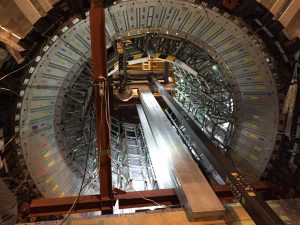 The first generation B-factory experiments, Babar and Belle, began data collection in 1999 at the asymmetric e+e– colliders PEPII at SLAC (Stanford, USA) and KEKB at KEK (Tsukuba, Japan), respectively. Within two years, both collaborations had attained convincing evidence of CP violation in B-meson decays, a discovery that netted theorists Makoto Kobayashi and Toshihide Maskawa a share of the 2008 Nobel Prize in Physics.
The first generation B-factory experiments, Babar and Belle, began data collection in 1999 at the asymmetric e+e– colliders PEPII at SLAC (Stanford, USA) and KEKB at KEK (Tsukuba, Japan), respectively. Within two years, both collaborations had attained convincing evidence of CP violation in B-meson decays, a discovery that netted theorists Makoto Kobayashi and Toshihide Maskawa a share of the 2008 Nobel Prize in Physics.
In the following years, the flavor sector of the Standard Model was explored, confirming the Cabibbo-Kobayashi-Maskawa quark mixing; the decay properties of B mesons, as well as charm mesons and tau leptons, were studied in depth, and new particles were discovered, some expected, like the ƞb, some puzzling, as the XYZs.
Following the great success of Babar and Belle, in 2010 the Japanese government approved the SuperKEKB project, a collider with a design luminosity of 8 x 1035/cm2/s, a factor-40 increase over the record achieved by KEKB. The greater part of the gain comes from significantly decreasing the beam sizes at the interaction point, based on the nanobeam collision scheme, an idea developed by Pantaleo Raimondi at Frascati National Laboratories for the SuperB project, and successfully tested at Dafne.
Belle II, the experiment designed to run at SuperKEKB, aims to reach unprecedented precision in a large number of measurements in the flavor sector. Over a decade, Belle II should be able to collect a data set of up to 50 billion pairs of B–anti-B mesons in a clean background environment. This will allow for probing signatures of new physics through suppressed flavor physics reactions, and crosschecks for deviations from the Standard Model measured at the LHCb experiment. In addition, Belle II will be an important competitor in the search for dark matter, ALPS (Axion-Like ParticleS), exotic quarkonium states, and more.
The higher luminosity of the collider poses formidable challenges to the detector, due to the increased background and higher data acquisition rates. To successfully run in the new conditions, the Belle components have been either substituted or upgraded: Belle II is the result of such improvements. The vertex detector is new, as well as the central drift chamber; a “time propagation’ detector (TOP) has been added to the particle identification system. The barrel electromagnetic calorimeter (ECL), consisting of thallium doped CsI crystals, has been equipped with a new readout; the glass RPCs of the KL and muon detector (KLM) have been replaced, in all but the external barrel layers, by scintillation counters. Both the trigger and the data acquisition systems are completely redesigned, to cope with the considerably higher event and background rates; the trigger has been modified to allow the possibility of detecting single photon events, a feature necessary to detect dark matter particles.
The SuperKEKB accelerator had its first successful test run in February 2017 (Phase 1). The Belle II detector was rolled in to the interaction point in April 2017, and all sub-detectors, except vertex detectors, were installed by fall 2017. Combined commissioning of the accelerator and detector (Phase 2) started in March 2018. SuperKEKB successfully delivered the first collision of electrons and positrons on the morning of April 26, 2018, with Belle II recording the interaction event signals. Running with the full detector (Phase 3) started in March 2019. At the end of July, a peak luminosity of 1.2x 1034/cm2/s was achieved, and the detector collected data for approximately 6.5 fb-1. The first results were presented at the Lepton Photon and other summer conferences.
At present, running has resumed with the goal of collecting data for 200 fb-1 by summer 2020.
The Belle II Collaboration
The Belle II collaboration extends over 4 continents, with approximately a thousand physicists and engineers from 116 institutions in 23 countries; the largest contingents are from Japan, Germany, the United States and Italy. INFN is present with about 80 people, from nine structures, including Frascati National Laboratory.
Activity of the Frascati group
The Frascati group joined Belle II in 2013; the first few years were devoted to R&D studies on a possible upgrade of the forward end cap electromagnetic calorimeter with different crystals and/or photodetectors. In 2016 Frascati joined the KLM group, and designed, built and commissioned the readout for the RPCs; now it is involved in the KLM data collection, the software for the identification of KLs, and the analysis of B decays involving KLs, in particular the B0→J/ψ KL.
Further references:
Belle II public webpage: https://confluence.desy.de/display/BI/Belle+II+Public+WebHome
Belle II-Italy: https://web.infn.it/Belle-II/index.php/divulgazione
 INFN-LNF Laboratori Nazionali di Frascati
INFN-LNF Laboratori Nazionali di Frascati